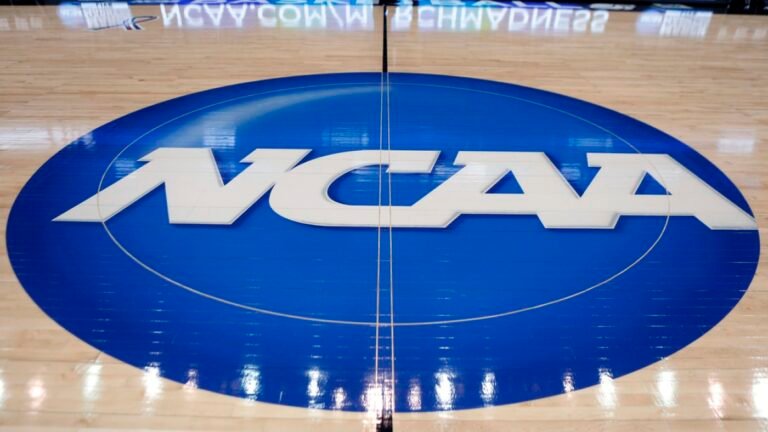The NCAA brand is displayed in 2015 at heart court docket at The Consol Vitality Heart in Pittsburgh.
Keith Srakocic/AP
conceal caption
toggle caption
Keith Srakocic/AP
The choose overseeing the rewriting of the faculty sports activities rulebook threw a doubtlessly deal-wrecking roadblock into the combination Wednesday, insisting events within the $2.8 billion antitrust lawsuit redo the a part of the proposed settlement involving roster limits that many faculties are already placing in movement.
“Any disruption which will happen is an issue of Defendants’ and NCAA members colleges’ personal making,” U.S. District Decide Claudia Wilken wrote in a pointed five-page order through which she gave no weight to the argument {that a} transforming of the proposal may throw school sports activities into chaos.
She gave the edges 14 days to contact their mediator and return to the bargaining desk.
The settlement within the landmark class-action lawsuit known as for colleges to not be certain by scholarship limits for his or her groups, however somewhat by roster limits through which everybody can be eligible for assist.
It figured to in the end weed out walk-ons, athletes on partial scholarships and, in excessive instances, whole groups. In making ready for the settlement to be authorized, colleges throughout the nation have been busy reducing gamers who, in flip, had been discovering spots on new groups.
Attorneys argued that undoing all these strikes would add much more turbulence to an already tumultuous panorama.
Not her downside, Wilken stated, in insisting either side jumped the gun in making the strikes.
“The truth that the Courtroom granted preliminary approval of the settlement settlement mustn’t have been interpreted as a sign that it was sure that the Courtroom would grant ultimate approval,” Wilken stated of the preliminary nod she gave again in October that set these transactions in movement.
Whereas the attorneys search for a Plan B, the clock is ticking. Phrases of the settlement had been supposed to enter impact July 1. Soccer apply begins quickly after. Whether or not rosters will are available in at across the previous common (128) or the newly prescribed restrict (105) is an open query.
One of many plaintiff attorneys, working nearly in lockstep with the NCAA and conferences since this settlement was (all however) locked in, launched a frightening assertion.
“We’ll work laborious to persuade the NCAA and the conferences to handle the court docket’s considerations,” Steve Berman stated. “If we’re unable to take action, then we’re off to trial and we’ll return to combating the NCAA in court docket with subsequent steps.”
The NCAA and 5 defendant conferences launched a joint assertion saying they had been intently reviewing the order.
“Our focus continues to be on securing approval of this vital settlement, which goals to create extra alternatives than ever earlier than for student-athletes whereas fostering much-needed stability and equity in school sports activities,” it stated.
Steven Molo, an legal professional who represented greater than 190 athletes at Wilken’s listening to earlier this month, seen the order as a victory of types.
“We’re grateful the court docket understood the ache the proposed settlement has been inflicting on many student-athletes who’ve devoted themselves to their sports activities,” Molo stated. “The large unfairness of the arbitrary roster limits have to be addressed.”
As for the remainder of the settlement — together with the $2.8 billion in again damages and the $20.5 million many faculties can dole out to their athletes — Wilken stated she’s able to go.
However this has been portrayed all alongside as an all-or-nothing deal, and although it was a mere matter of routine, Wilken’s launch of a pretrial schedule — with some hearings scheduled out by September —underscored the concept, certainly, there’s no less than an opportunity this lawsuit could possibly be resolved with a trial.
Not that any of this could have stunned the attorneys.
Wilken made clear towards the tip of the daylong settlement listening to April 7 that she would love the events to discover a approach to step by step implement the roster-limit guidelines. She steered “grandfathering in” athletes who already had roster spots. In her order Wednesday, she insisted that wasn’t as unimaginable because the attorneys made it sound.
“A method of attaining that could possibly be to change the settlement settlement to make sure that no (athletes) who’ve or had a roster spot will lose it on account of the quick implementation of the settlement settlement,” she wrote. “Limits could possibly be completed step by step by attrition.”
Wilken additionally rejected attorneys’ arguments that, basically, the nice being completed for hundreds of athletes who can now receives a commission (and who might need a beforehand unavailable shot at a scholarship) offsets no matter harm takes place to the gamers who discover themselves at new colleges — or no faculty in any respect.
“The Courtroom can approve the settlement settlement solely whether it is truthful, cheap, and enough after contemplating, in related half, whether or not it ‘treats class members equitably relative to one another,'” Wilken wrote, in quoting a earlier ruling.
It’s not clear what number of roster spots throughout lots of of colleges will vanish below the settlement, although some estimates have pegged the quantity within the hundreds.
What is certain is that this ruling shoves the colleges’ makes an attempt at preparing for 2025-26 a step deeper right into a black gap of uncertainty. Additionally clear: the choose is each bit as involved concerning the lots of of athletes dropping roster spots as she is with the multibillion-dollar trade they inhabit.

